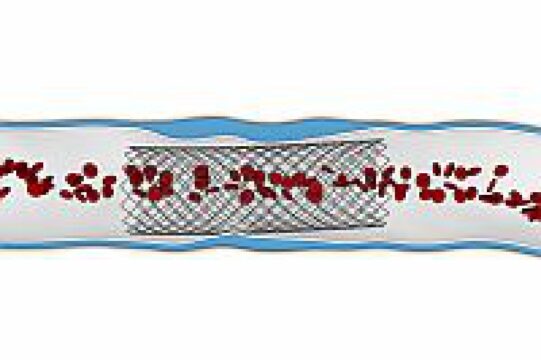Original title: Clinical and Procedural Predictors of Suboptimal Outcome After the Treatment of Drug-Eluting Stent Restenosis in the Unprotected Distal Left Main Stem The Milan and New-Tokyo (MITO) Registry. Reference: Circ Cardiovasc Interv. 2012;5: 491-498 We have very little data on the percutaneous treatment of restenosis of an unprotected LMCA. The aim of this study was to evaluate…
Future strategies to prevent restenosis and stent thrombosis
Original title: Endothelial cell repopulation after stenting determines in-stent neointima formation: effects of bare-metal vs. drug-eluting stents and genetic endothelial cell modification. Reference: Douglas G et al. European Heart Journal doi:10.1093/eurheartj/ehs240 Experimental models of vascular injury have shown that the rate of endothelial cell repopulation post-injury is a critical factor in determining subsequent neointima formation as well as…
Complex angioplasty with ventricular assist
Original title: Real-Word of the Impella 2.5 Circulatory Support System in Complex High-Risk Percutaneous Coronary Intervention: The USpella Registry Reference: Brijeshwar maini, et al. Catheterization and Cardiovscular Intervention For about a decade angioplasty has begun to be performed in increasingly complex patients (PE) such as those with left coronary trunk injury, 3-vessel injury, poor ventricular function and surgically…
High-dose atorvastatin for prevention of contrast nephropathy
Original title: Impact of a High Loading Dose of Atorvastatin on Contrast-Induced Acute Kidney Injury. Reference: Quintavalle et al. CIRCULATIONAHA.112.10331, 2012 Patients included in this study represent a subgroup with chronic renal failure (CRF) enrolled in the NAPLES II trial who were randomized to atorvastatin 80 mg 24 hours before angioplasty, (n = 202) versus the control group…
Again in the bifurcation, less is more.
It has been reported that the two stents technique is not superior to a provisional stent when treating bifurcations. However, the optimal approach to rescue a secondary branch (SB) when initially opting for provisional stenting has not been established. The aim of this study was to determine angioplasty indication using balloon or stent for…
The use of a paclitaxel eluting balloon in small vessels
Original title: A Randomized Multicenter Study Comparing a Paclitaxel Drug-Eluting Balloon With a Paclitaxel-Eluting Stent in Small Coronary Vessels. The BELLO (Balloon Elution and Late Loss Optimization) Study Reference: Referencia: Azeem Latib et al J Am Coll Cardiol 2012;()doi:10.1016/j.jacc.2012.09.020 The utility of paclitaxel-eluting balloons to treat in-stent restenosis is known but data for novo lesions is more limited. …
What are the chances we presently have of carrying a cardiovascular disease at some point in our lives?
Original title: Lifetime Risk and Years Lived Free of Total Cardiovascular Disease Reference: John T. Wilkins et al. JAMA. 2012; 308(17):1795-1801. This study analyzed more than 120,000 patients in the cohorts of large community studies, such as the Framingham, who did not have cardiovascular disease at the time of inclusion Considering all the age subgroups, only between 1.7%…
A new paradigm in the treatment of in-stent restenosis?
Original title: ISAR DESIRE 3: Drug-eluting balloon is best option for restenosis of limus-eluting stents Reference: Dr Robert Byrne. TCT 2012. Miami, Fl. The first of the ISAR DESIRE trials showed that drug-eluting stents (DES) were the best strategy for treating restenosis of a bare metal stent, the second ISAR DESIRE trial tested the hypothesis of changing or…
Diabetics with multivessel, must keep waiting.
Original title: Strategies for Multivessel Revascularization in Patients with Diabetes. The FREEDOM Trial. Reference: Michael E. Farkouh et al. N Engl J Med 2012. DOI: 10.1056/NEJMoa1211585 This study was designed to determine the best revascularization strategy in diabetic patients with multivessel using current techniques of angioplasty (PCI) and surgery (CABG). Randomized 1:1 diabetic patients with injuries > 70%…
Future second-generation stents, today.
Original title: First Serial Assessment at 6 Months and 2 Years of the Second Generation of Absorb Everolimus-Eluting Bioresorbable Vascular Scaffold A Multi-Imaging Modality Study. Reference: John Ormiston et al. Circ Cardiovasc Interv. 2012;5:620-632. The first bioabsorbable stents eluting everolimus showed a 6-month delayed recoil resulting in late lumen loss of 0.44 mm, (intermediate between a metal stent…
Global Risk Score for stratification of patients with multivessel coronary artery disease: A wider look
Reference: Serruys et al J Am Coll Cardiol Intv 2012;5:606–17 SYNTAX Analysis study demonstrates the utility of a new risk score for patients stratification with left main coronary artery or multivessel disease. Numerous studies have demonstrated the value of SYNTAX score to stratify risk of angioplasty and decision-making (angioplasty versus surgery) in patients with multivessel…


